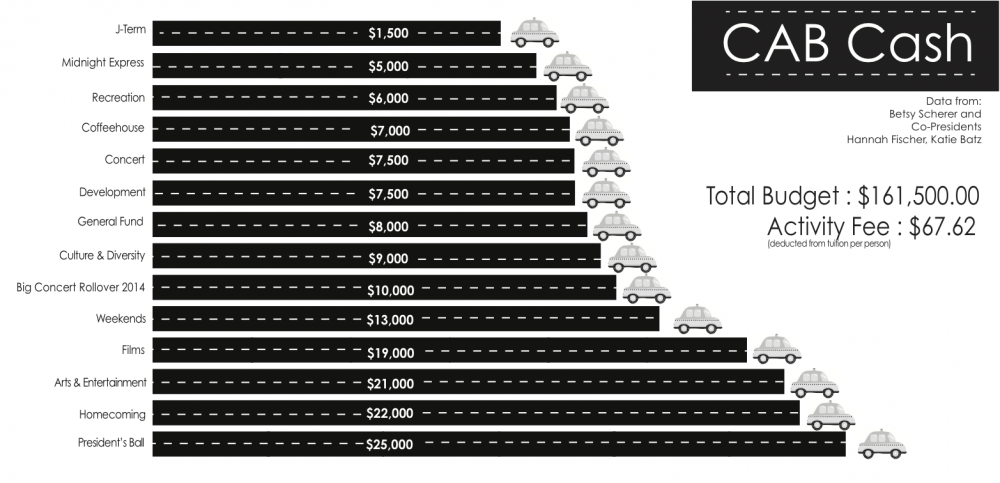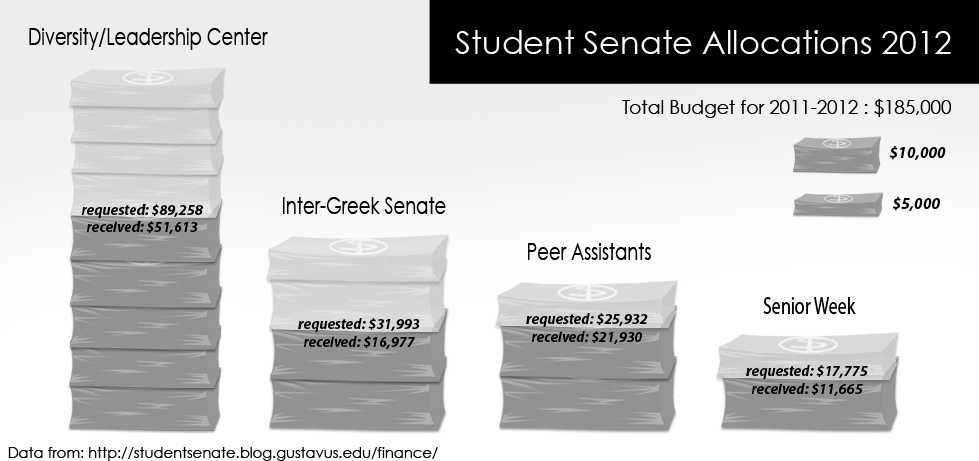The Student Activity Fee is distributed to both Student Senate who received 54 percent this year and the Campus Activities Board (CAB) who received 47 percent. Next year Building Bridges will receive 3.5 percent and Student Senate will drop to 49.5 percent and the CAB will receive the same percent as this year.
“The Student Activity fee is an amount charged each year to every Gustie (separate from tuition) and those funds are used to support student programming,” JoNes VanHecke, Dean of Students and Vice President of Student Life, said.
“Next year the student activity fee funding will be used to support CAB, Building Bridges, the Newspaper Readership Program, the Gus Bus and via Student Senate distributions, clubs, organizations and club sports,” VanHecke said.
The Campus Activities Board

The 47 percent allocated to the CAB goes toward all events put on by the organization. This includes weekend movies, President’s Ball, Homecoming (which includes a concert free to students), the big concert (every other year), big speakers (also every other year), Coffeehouse events, Saturday Night in Lund, etc.
CAB is allocated a large amount of money because they are responsible for most of the on-campus events. Their budget is not public as they are a separate organization. Their budget is broken down into three main parts: funds for the aforementioned events (recreation events), a general fund and a development fund.
The weekend events fund covers the first three weekends of every semester such as the hypnotist during first-year orientation, family weekend, Dueling Pianos and Saturday Night in Lund. The weekend movie plays five times every weekend and to buy the rights to the movie costs on average of 640 dollars.
The general fund is money used as a transfer between accounts. When organizations request that the CAB co-sponsor them, the money comes out of the general fund. Also if some events are under budget, e.g. coffeehouse, then money from that event will be used to co-sponsor other organizations.
The upcoming academic year is a Big Speaker year so the funds for the Big Speaker come out of the recreation fund. When booking any big speaker with a well-known name the funds start at 15,000 dollars. Also out of the recreation fund comes the chance for two professional sporting events along with events like the Gustie Cup.
A big concert is held every other year as well, and money is set aside in order to have a greater amount to use when the concert year rolls around.
Events like the President’s Banquet have scholarships available to those for whom the ticket price is too large. The ticket price helps cover all the additional parts involved e.g. transportation, decorations, three-course meals, venue and performers.
The development fund is used to train the CAB staff. This money goes toward two things: The National Association of Campus Activities (NACA) and the fall retreat. The NACA conference is an expensive trip but allows the staff of CAB to learn the skills necessary to sponsor the events seen on campus. Not only that, when seeking entertainers and performers, CAB saves an estimated 4,000 dollars from having participated in the conference.
“We can’t stress enough how important the conference is. Without going to it, we wouldn’t be able to put on any of the events we do,” CAB Co-President Hannah Fischer said.
Student Senate

The amount given to the Student Senate is distributed among all registered on-campus organizations for their individual budgets.
Registered organizations send the Student Senate their budgets in the spring for the following academic year. They continue by meeting with the Finance Committee of Student Senate and discuss their requested budget upon which time the Finance Committee will recommend a budget based on the bylaws of Student Senate.
From here, the budget ascends to full Senate where the budget is voted on which allocations are appropriate. There are around ninety registered organizations on campus this year.
During the spring budget planning, Student Senate makes an educated guess on how much money will be brought in from the Student Activities Fee for the upcoming year. That number is then used to budget for organizations.
Over the summer the money gets transferred into the Student Senate accounts and they know the exact amount. In case of errors, Student Senate is required to roll over at least 10,000 dollars into a separate account. At midyear if organizations request more money, the money they receive comes from the rollover account. Because of the large incoming class, the rollover account is anticipated to be far greater than 10,000 dollars.
The Student Activities Fee designates 20 dollars from everyone’s payment for the readership program that allows newspapers to be on campus every day. Student Senate is in charge of the program that distributes all of the newspapers found around campus.
The budget of Student Senate is completely transparent and can be viewed online in full. This includes an itemized budget list of every registered organization on campus.